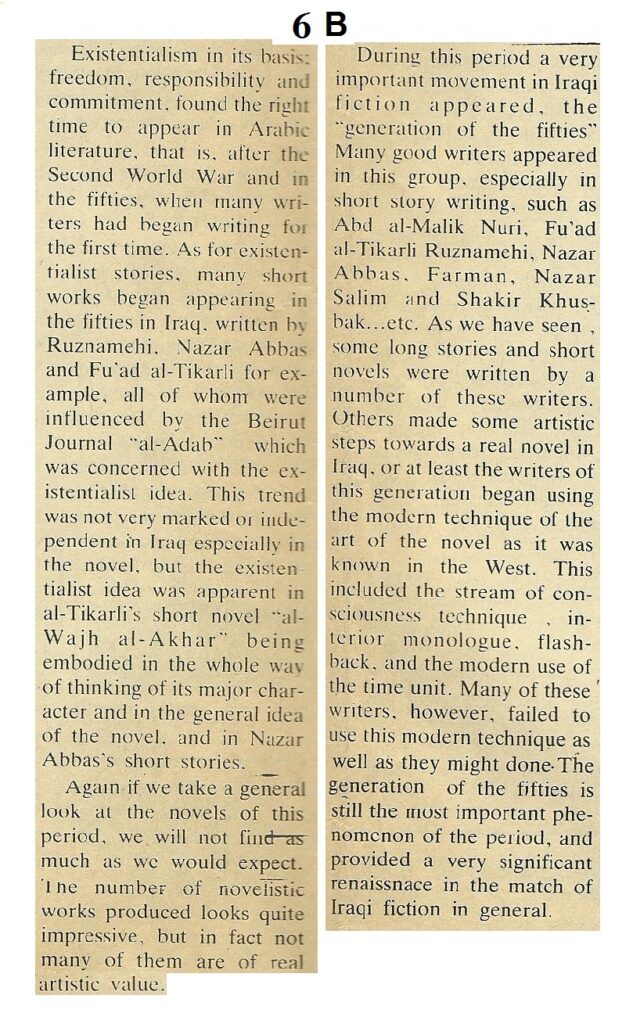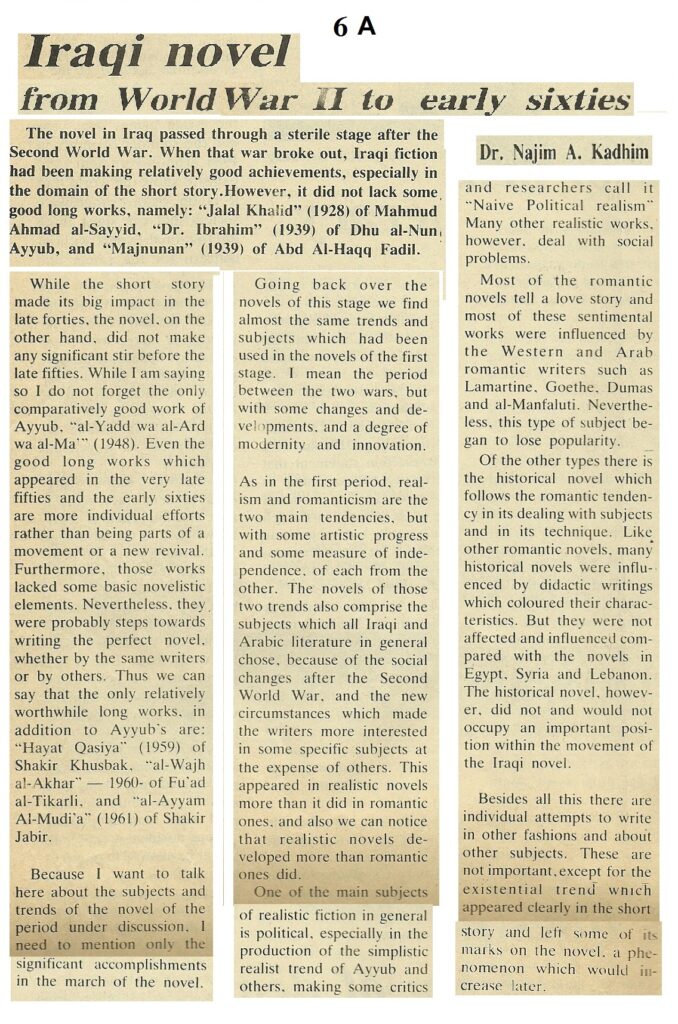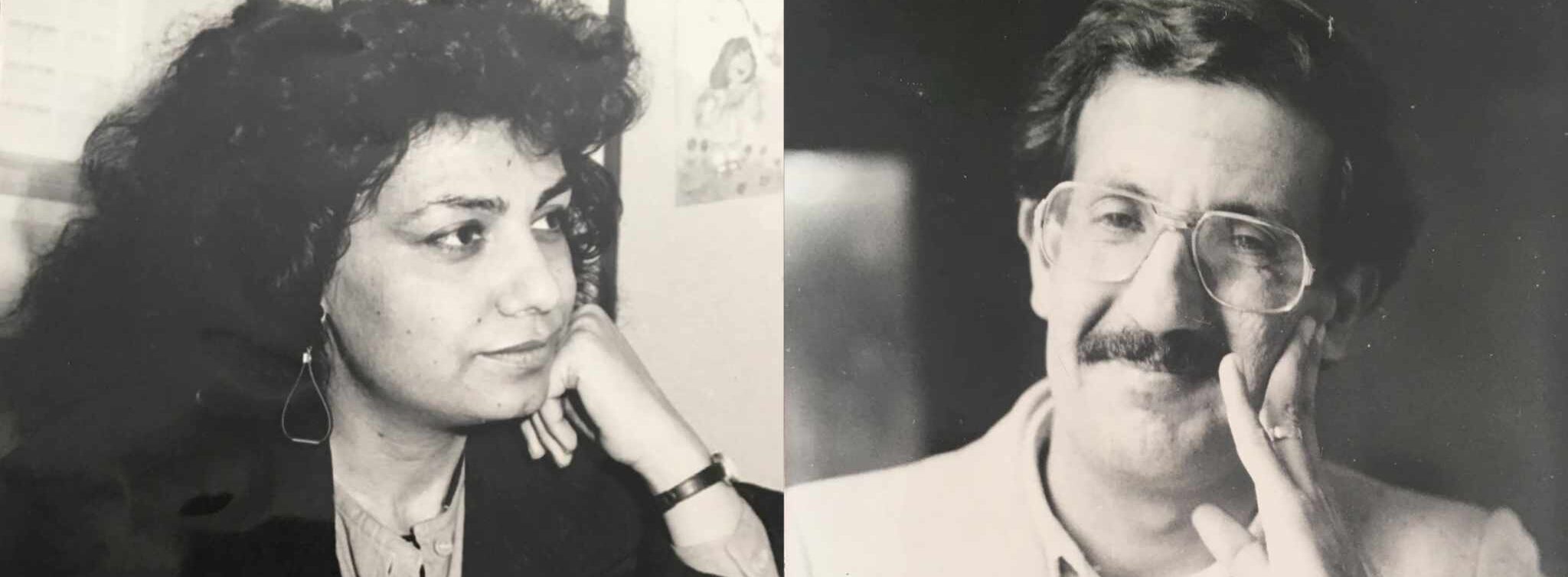IRAQI NOVEL
FROM WORLD WAR II TO THE EARLY SIXTIES
Dr. Najim A. Kadhim
(1)
It is well known that the novel in Iraqi passed through sterile stage after the Second World War. When that war broke out, Iraqi fiction had been making relatively good achievement, especially in the domain of the short story. However, it did not lack some good long works, namely: “Jalal Khalid” (1928) of Mahmud Ahmed Al-Sayyid , “Dr. Ibrahim” (1939) of Dhu Al-Nun Ayyub, and “Majnunan” (1939) of Abd Al- Haqq Fadil.
While the short story made its big impact in the late forties, the novel, on the other hand, did not make any significant stir before the late fifties. Having said this, I do not forget the only comparatively good work of Ayyub, “Al-Yadd wa al-Ard wa al-Ma’a” (1948). Even the good long works which appeared in the very late fifties and early sixties are more individual efforts rather than being parts of a movement or new revival. Furthermore, those works lacked some basic novelistic elements. Nevertheless, they were probably steps towards writing the perfect novel, whether by the same writers or by others. Thus we can say that the only relatively worthwhile long works, in addition to Ayyub’s are: “Hayat Qasiya” (1959) of Shakir Khusbak, “Al-Wajh al-Akhar” (1960) of Fu’ad Al-Tikarli, and “Al-Ayyam Al- Mudi’a” (1961) of Shakir Jabir.
Because I want to talk here about the subjects and trends of the novel of the period under discussion, I need to mention only the significant accomplishments in the march of the novel.
Going back over the novels of this stage we find almost the same trends and subjects which had been used in the novels of the first stage, I mean the period between the two wars, but with some changes and developments and a degree of modernity and innovation. As in the first period, realism and romanticism are the two main tendencies, but with some artistic progress and some measure of independence, of each from the other. The novels of those two trends also comprise the subjects which all Iraqi and Arabic literature in general chose, because of the social changes after the Second World War, and the new circumstances which made the writers more interested in some specific subjects at the expense of others. This appeared in realistic novels more than it did in romantic ones. We can also notice that realistic novels developed more than romantic ones did.
One of the main subjects of realistic fiction in general is political, especially in the production of the simplistic realist trend of Ayyub and others, making some critics, researchers and scholars call it “Naive Political realism”. Many other realistic works, however, deal with social problems. Most of the romantic novels tell a love story and most of these sentimental works were influenced by the western and Arab romantic writes such as Lamartine, Goethe, Dumas and al-Manfaluti. Nevertheless, this type of subject began to lose popularity.
Of the other types is the historical novel which follows the romantic tendency in its dealing with subjects and in its technique. Like other romantic novels, many historical novels were influenced by didactic writings which coloured their characteristic. But they were not affected and influenced by those writings compared with the novels in Egypt, Syria and Lebanon. The historical novel, however, did not and would not occupy an important position within the movement of the Iraqi novel.
Besides all this are individual attempts to write in other fashions and about other subjects. These are not important, except for the existential trend which appeared clearly in the short story and left some of its marks on the novel, a phenomenon which would increase later. Existentialism in its basis: freedom, responsibility and commitment, found the right time to appear in Arabic literature, that is, after the Second Would War and in the fifties, when many writers had began writing for the first time. As for existentialist stories, many short fictional works began appearing in the fifties in Iraq, written by Muhammad Ruzanamehi, Nazar Abbas and Fu’ad Al-Tikarli for example, all of whom were influenced by the Beirut Journal “Al-Adab” which was concerned with the existentialist idea. This trend was not very marked or independent in Iraq especially in the novel, but the existentialist idea was appeared in Al-Tikarli’s Short novel “Al-Wajh al-Akhar” being embodied in the whole way of thinking of its major character and in the general idea of the novel, and in Nazar Abbas’s short stories
Again if we take a general look at the novels of this period, we will not find as much we would expect. The number of novelistic works produced looks quite impressive, but in fact not many of them are of real artistic value.
(2)
During this period a very important movement in Iraqi fiction appeared, that is the (generation of the fifties). Many good writers appeared in this group, especially in short story writing, such as Abd Al-Malik Nuri, Fu’ad Al-Tikarli, Muhammad Ruznamechi, Nazar Abbas, Gha’b Tu’ma Farman, Nazar Salim and Shakir Khusbak…etc. Some long stories and short novels were written by a number of these writers. Others made some artistic steps towards a real novel in Iraq, or at least the writers of this generation began using the modern technique of the art of the novel as it was known in the West. This included the stream of consciousness technique, interior monologue, flash-back and the modern use of the time unit. Many of these writers, however, failed to use this modern technique as well as they might have done. The generation of the fifties is still the most important phenomenon of the period and provided a very significant renaissance in the match of the Iraqi fiction in general.
Although the generation of the fifties concentrated on short story writing, creating the most important short stories in the history of Iraqi Fiction, some of its writers also wrote long works. We previously knew that their experience with long fiction writing were before the revolution of 1958. Now we are going to follow their march after the revolution when some important short novels and long stories appeared.
It is true that the first post-revolutionary period witnessed a flourishing in writing publishing, criticism and reading. Fiction of that period, which is known by the term “fiction of the early response to the revolution”, was mostly short stories. These short stories and a very few novels usually dealt with political and local social subjects, portraying the life of the Iraqi people before the revolution and their suffering torture and starvation. Soon this kind of fiction disappeared from literary life “because,” says Abdulilah Ahmed, “soon this revolution revealed its incompatibilities. People’s enthusiasm subsided and their hopes changed to desperation, fear and expectation. This was the beginning of a weakness that would prevail in literary life and the end of an era within this literary life”.
This was one of the many reasons for the weakness and then the silence of the generation of the fifties. Besides, the revolution itself was a reason for some writers who were used to dealing with different circumstance and subjects, to become silent because they could not deal with the new material and subjects which the revolution offered, because, as Fadhil Thamir says, of ” the definite understanding which he (the fiction writer of the fifties) used to base himself/herself on, in his/her writing of the art of fiction, that is to say: the aggressive critical function which is the destroyer of the underdeveloped reality”. So, in the face of the revolution and what it achieved, the writer of fiction felt that his function had ended. Afterwards very few of them resumed writing, but from within a new movement or generation of writers appeared in the sixties.
However, some good distinguished long works appeared within the early years of the revolution (1959-62), which we believe to belong to the production of the generation of the fifties and we are therefore going to study. But before that, we must mention that one of the major factors contributing to the advanced artistic achievement of this generation was their wide reading of modern Western fiction. Khudayyir Abdul Amir says: ” A new generation of writers appeared representing a developed awareness which sprang in its origin from Russian fiction and realism of its pioneers like the works of Maxim Gorki, Fyodor Dostoyevsky, Ivan Turgenev and others to a sharp and exposed critical realism being represented by American fiction in the works of Erskine Caldwell, John Steinbeck, Howard Fast, Richard Wright and others”.
(3)
As we are concerned here with novels and long stories, we find that of about thirty works which were published in the fifties and early sixties there are only few worth to be studied. We are going to study two of the best three works, leaving the third, which is the best of them to a coming article. Other than these works are very few which achieved anything at all in terms of the art of the novel and we shall omit these from this study.
After his first relatively long work, “Ahd Jadid”, Shakir Khusbak published a second long one, within a collection of stories. “Hayat Qasiya” (Hard Life)-1959- tells about a spinster who lacks beauty, and this makes her suffer from sexual and emotional frustration. This worsens the tragic life she is already living, with her parents. All this enables Halima to be easily deceived by Fadil, the young grocer whom she believes is in love with her. However, Halima’s story ends tragically when Fadil tries to seduce her, and as a result makes her run to the river, as it is understood, decides to throw herself into it from the bridge. This end reminds us of Najib Mahfuz’s “Bidaya Wa Nihaya” (1949), which, in its main theme, deals with the same subject in almost the same way.
Although “Hayat Qasiya” is more like a short story than a novel, it is true that this work is longer than the normal length of the short story as it was and is known in Iraq. It also has some of the aspects of the novel, which perhaps makes it the potential new material of a novel
The second novel to be studied her is Shakir Jabir’s “Al-Ayyam al-Mudi’a (Shining Days)-1961- about which it was said: “It is a unique original work in the history of modern Iraq literature; whenever the reader reads it… he/she feels himself/herself to be continually stimulated as long as he/she is reading. That is the stimulation of the pouring of life, which the writer succeeds in infusing in it… ” (Abdalilah Ahmad). Mahmud in ” al-Ayyam al-Mudi’a comes with his very simple background of culture and general knowledge, from a small city in southern Iraqi to Baghdad, the very big capital city, after he has won the fight with his father about attending university. Soon he finds himself in a new society, a new world which he has never before. Everything is different from what he has been used to. Two threads begin to knit his new life in this new world: love, which a female student awakens in him; and politics, which are brought to his mind by many things, his old friend Zaki who is experience and well-educated, the other students, his new non-student friends- especially Wahhab, the girl Madiha whom he loves, the people in Baghdad, the books and newspapers he begins to read, and life in general as it begins to be more obvious to him when the flood of the river washes away many poor people. As Madiha marries another student, his love ends sadly, but politics make him a completely new person, a person who is aware and can understand what is around him. And that is the reason for his being dismissed from the university, as we learn from the last two pages, when he meets Madiha on a train. After a conversation between them, Mahmud as narrator says in the very last sentence, “And the train is still running as we recall our memories… and our shining days”.
Some critics have argued that the end of “Al-Ayyam al-Mudi’a” is one of the best climaxes in artistic fiction, and the short novel itself is believed to be one of the best long works to be written in Iraq up to the mid-sixties. However we must not forget here “Al-Wajh al-Akhar” of Fu’ad Al-Tikarli. It and its writer will be the subject of a coming article.


 ميسلون هادي والدكتور نجم عبدالله كاظم موقع الكاتبة العراقية ميسلون هادي و الدكتور نجم عبدالله كاظم
ميسلون هادي والدكتور نجم عبدالله كاظم موقع الكاتبة العراقية ميسلون هادي و الدكتور نجم عبدالله كاظم